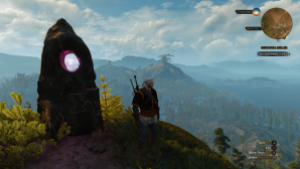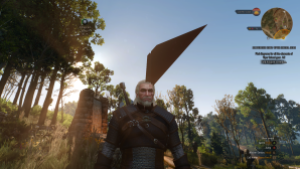PART 1 – ICKY WITCHER (4 Sept. 2015)
By the time you read this it will have been September for at least a few days. This means, undoubtedly, an endless stream of friends asking what we did this summer. I, having been well trained in the art of back-to-school vacation reporting, dutifully explain that I spent the whole summer preparing for my qualifying exams. This entails reading through 20 books on queer theory, 20 more books in game studies, watching 40 or so films related to LGBT history and queer representation, and playing through 40 or so video games. And yet, at the end of the summer I still wonder if in all of this reading, watching, and playing I’ve learned anything at all. I should probably try to see if knowledge has happened and then share that knowledge with some other people to see if they think it’s knowledge, too. Maybe a four week series of blogposts right at the end of the summer – a kind of Summer In Review of games, gender, sex, and film. Give it a catchy title. Sure.
PLAYING, WATCHING, WANTING: A SUMMER IN REVIEW. PART 1 – ICKY WITCHER
Let’s start by thinking about a guy provocatively named the Bloody Baron. Philip Strenger, a.k.a., the Bloody Baron, is a key character in the opening third of The Witcher 3: Wild Hunt (2015, Xbox One, PS4, PC), a sprawling role playing game by Polish game studio, CD Projket RED. This game is massive. Wild Hunt combines the expansive environment of Bethesda’s Skyrim with the deep characterization and romantic interludes of Bioware’s Mass Effect series, and throws in an entirely original trading card game, complete with factions and gold foil cards for good measure.
(Really, really sprawling)
However, it also introduces players to a terribly cruel world. Nobles squabble for control over their small corner of the world, always seeking to expand that corner by whatever means necessary, and Wild Hunt is unflinching in its depiction of how these squabbles disenfranchise the less well-off citizens of the Northern Kingdoms. The Bloody Baron, however, tells us the most about what we expect from our games, our games press, and the way sex and patriarchal oppression operate in video games.
Before we get to that, let’s backtrack.
The Witcher 3: Wild Hunt launched just before this summer started. It was hotly anticipated by nearly every gaming media outlet and was immediately met upon release with virtually universal critical and popular acclaim. CD Projekt RED had an enormous success on their hands and the adoration of millions of fans due to fan-friendly business practices like weekly installments of free downloadable content (DLC) and frequent, personal communication with a demographic known for being extraordinary fickle. This rabid affection explains at least some of the intense anger that fans launched at Arthur Gies’ review of The Witcher 3 for Polygon.com.
In this largely positive review, Gies still expressed reservations about the constant and often gruesome violence to which women are subjected in The Witcher 3. Gies calls “the world CD Projekt has created […] oppressively misogynist,” and, though he acknowledges that the game deals with this misogyny directly, Gies also points out that the game seems to, at least a little, relish the many opportunities to depict women in peril. As Gies puts it, the world of The Witcher 3 has many women characters who struggle mightily – and not always in vain – against a viciously oppressive society, but then the game “kills them, over and over.
As you might expect in a post-but-not-at-all-post #GamerGate world, a review score of 8 out of 10 for a beloved game is an outrage, doubly so since the score seemed to rest on the objections of an SJW (Social Justice Warrior for those not in the know). Gies had previously been pilloried for his similarly positive yet hesitant review of Bayonetta 2 (2014, Wii U) and the gaming masses seemed ready to put him to the stocks again for this second, even more egregious sin. Fans of The Witcher 3 took to their blogs, message boards, and online communities to criticize Gies and Polygon for their review. One fan’s response characterizes the overall backlash quite well:
“Polygon is nothing but jaded old journalists with absolutely no love for gaming anymore. I lost respect for them years ago.”
Another fan in the same thread had this to say:
“The world in The Witcher is supposed to be portrayed as brutal and unfair. Racism, sexism, and the works are all prevalent. It just looks so silly to throw that stuff around in a review. It’s Polygon trying to sound cerebral, and coming off more as pompous.”
Even more damning, Adrian Chmielarz, co-owner and creative director of small indie studio The Astronauts and developer of such cult hit games as Painkiller (2004) and Bulletstorm (2011) wrote a long, scathing blog post calling Gies’ piece, among other things, “poisonous to the industry,” and an example of toxic journalistic incompetence endemic to the game review industry.
If you’ve been at all familiar with the #GamerGate saga over the past year (and if you’re not, I recommend this article from Ars Technica for a taste), then these objections might sound familiar to you. They have that je ne sais quoi of reactionary masculinist discourse that seems to characterize so much of online reddit/chan/gaming culture right now.
However there is something in the fan response to Gies’ review that, despite its histrionic tone and defensive articulation, warrants attention.
(In the same way that this glitched polygon warrants attention)
Let us grant Gies’ criticism that the world of The Witcher 3 is ruthlessly misogynist (it is) and that the game itself seems to at least, in some way, revel in women’s suffering, all the while dressing its many prominent women characters in laughably sexy costumes (it does). For sure, there is plenty to feel icky about in The Witcher 3. The question that Gies does not get to though, and the question that I think his critics in some way articulate, is this: does the game itself feel icky about its content? Or, put another way, does Wild Hunt encourage players to maintain or develop a critical perspective on a patriarchal society that often mirrors our own?
The answer, I think, is a resounding “yes.” Mostly anyways. As players assume the mantle of the Witcher himself, Geralt of Rivia, they also take on a social role that places them as both an outsider to and beneficiary of Wild Hunt’s “oppressively misogynist” world. Along with this unique point of player identification, The Witcher 3 offers (via its fantasy narrative and iconography) a range of viscerally-realized metaphors that, at times, make the player’s role of killing the monsters of the Northern Kingdom seem uncannily like a crusade against the patriarchy.
Whether The Witcher 3: Wild Hunt makes players complicit in a virtual Malleus Maleficarum or waltzes them around in the boots of a strangely familiar white knight, it is the episode with the Bloody Baron – drunkard, wife-beater, war hero, contrite father – that best exposes the complexities of gender and sexuality at work here. The reactionaries against Gies’ review may not have had what I argue in mind, but if gaming is ever going to move out of its current atmosphere of division, exclusion, and prejudice, then we need to work harder than Gies’ review does at understanding how games go about their representational business. Next week, I’ll try to do just that with the story of Geralt of Rivia and the Bloody Baron of Novigrad.
Jordan Wood is a Ph.D student in the Syracuse University English department where he studies games, sexuality, and queer theory. He lives with two cats and is terrible at side scrolling games. Go Bills.



